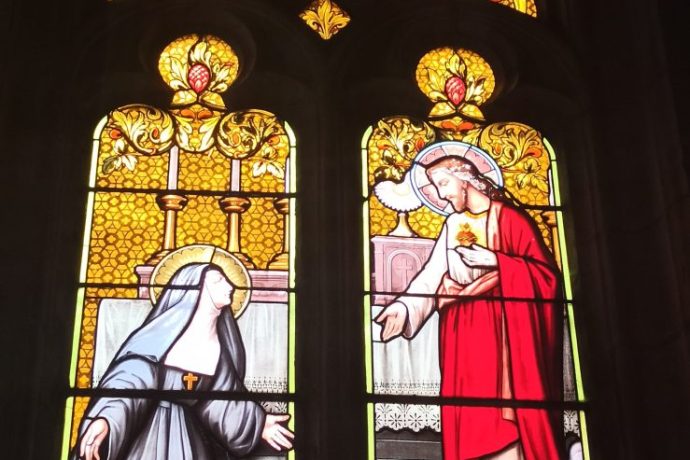Rebuilt in 1908, the bell tower has its current spire, and three new bells are installed.
Inside, 25 beautiful carved wooden stalls dating from 1847 have been listed as Historic Monuments since May 3, 1904.
The bell tower, destroyed during the Revolution, was rebuilt around 1825.
In 1905, a fire ravaged the bell tower which collapsed on the sacristy. It was then that the current spire was raised. Inside, very beautiful carved wooden stalls dating from 1847 are classified as Historic Monuments.
The stalls are located in the choir of the church. Each stall has a more or less high backrest, a mercy, a projection fixed under a flap that allows members of the clergy to lean or sit down during services.
In 1115, it is attested to the existence of a priory in Meximieux, this one dependent on the abbey of Ambronay, an act of 1478 located it in the “Fouilloux” district.
The Saint Apollinaire church mentioned in 1183, of a more modest size than that existing today, occupied the site where the choir of the current church is located.
This church was not parochial, this title going to the Saint Jean Baptiste church of the priory which was on a ''motte'' a few hundred meters below.
Significant changes occurred in the XNUMXth century when the Lord of Meximieux François Maréchal obtained that the Saint Apollinaire church be erected as a collegiate church, with a chapter of six canons.
A bull from Pope Leo X in 1515 transferred all the property of the priory, including the church of Saint Jean Baptiste, to the chapter of Meximieux.
During the Revolution, the National Assembly voted on July 12, 1790 to abolish the chapters and priories. Under pressure and for fear of reprisals, the parish priests of Meximieux complied and completely ceased services on December 31, which did not prevent some from experiencing detention in the district prisons.
The three bells were recovered by the Revolutionaries and transported, like all those seized in the region, to the foundry of Pont de Vaux.
The bell tower protrudes from the roof and dominates the village, so it is razed.
The building cut off from its bell tower will be used as a meeting room for the people, for popular festivals and as a storage warehouse.
Finally, in 1803, the churches were returned to worship. The bell tower is rebuilt but the population has increased and the church is too small.
From 1822 to 1842, the bell tower was rebuilt, the building enlarged by the addition of two bays on the west face, the facade was moved forward.
Again work and expansion were carried out in 1847 to give the current building.
On December 18, 1905, the bell tower went up in smoke following an accidental fire in the sacristy, the spire collapsed, the bells fell into the choir and broke.
At the beginning of 1907 a new bell tower was built, in the shape of a neo-Gothic arrow. The same year, the founder Paccard from Annecy was consulted to make three new bells, reusing the debris of the broken ones.
On October 11, 1908, Bishop Labeuche blessed the new bells before they were mounted in the bell tower: Claudine in E-flat, 1240 kg, Jeanne in G 620 Kg and Marie in C 269 Kg.
This church went through two world wars without suffering any damage but had to be renovated internally and fitted out in 1963 and 1964.
Themes
- Religious Heritage
- Church
Types
- Historic site and monument
Adapted tourism
- Wheelchair accessible with assistance
Customer base
Maximum group size: 70
Prices
Free
Opening
Open every day of the year
Advice from the Office
In case of rain
Do not panic ! Here are all our sheltered activities.
On the way back
To bring back a souvenir or something to treat yourself, stock up on local products from Pérouges in Bugey.





